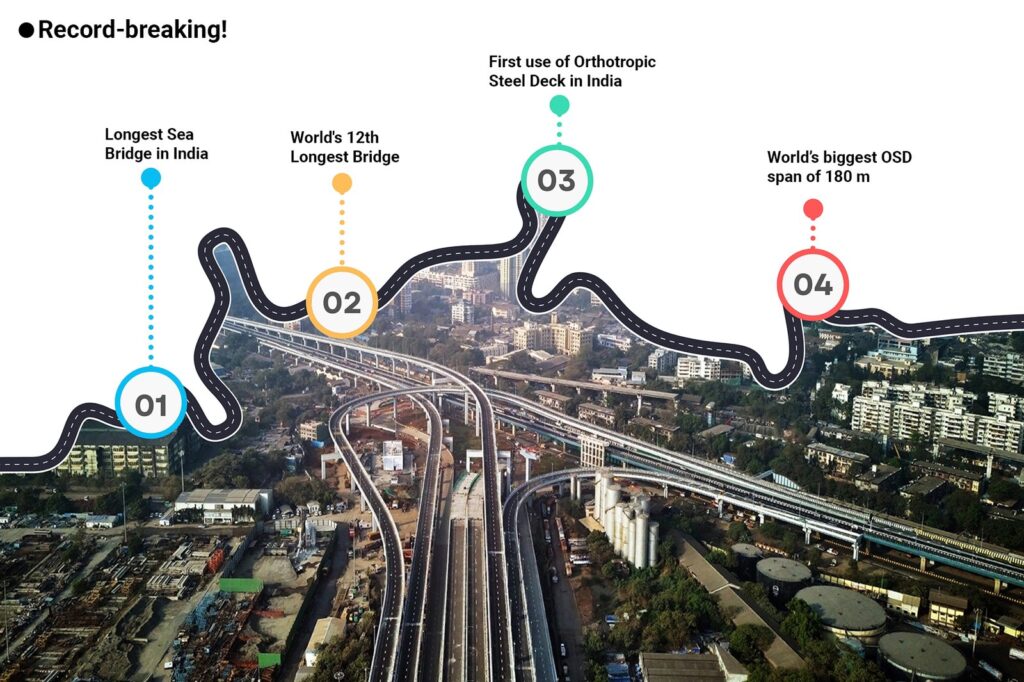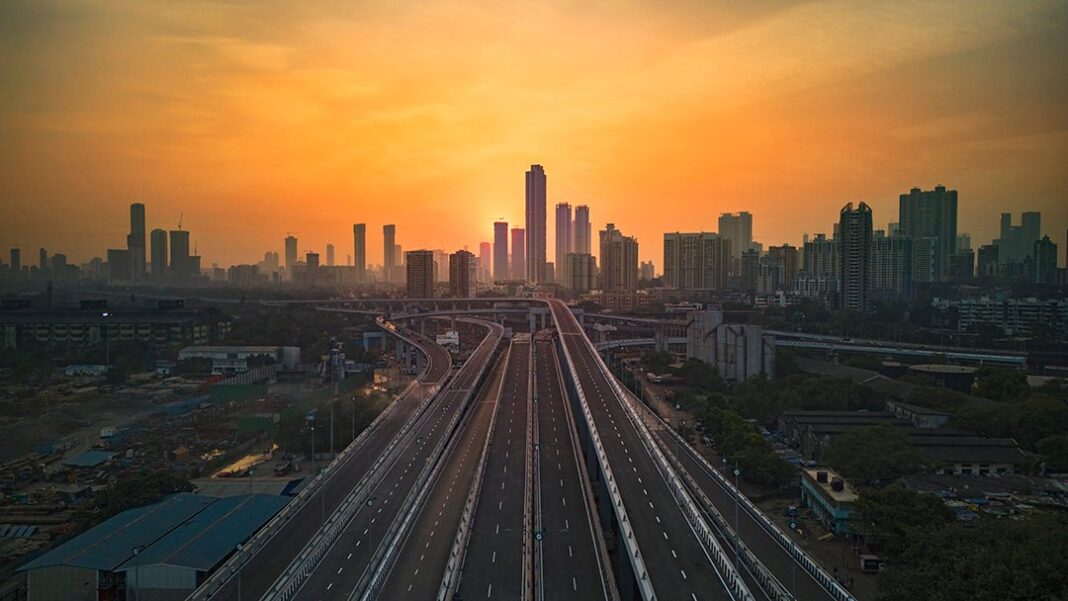Embarking on an odyssey that echoes a vision from the 1970s, the Mumbai Trans-Harbour Link has emerged as India’s triumph of innovation and engineering prowess. It not only connects Mumbai to Navi Mumbai, but secures its place as the 12th longest bridge in the world. From breaking records to introducing some firsts in India, this colossal sea bridge stands as a testament to technological excellence.
Prime Minister Narendra Modi set the stage for a grand unveiling as he inaugurated the Mumbai Trans-Harbour Link (MTHL), officially named as Shri Atal Bihari Vajpayee Trans Harbour Link (Atal Setu), the country’s longest sea bridge.
Beyond the MTHL’s impressive
21.8 km stretch connecting Mumbai to Navi Mumbai, it also secures its place as the world’s 12th longest bridge.
Born from a vision in the 1970s, the six-lane MTHL project finally took shape in 2017 after five attempts and reached completion in the early months of 2022.
With an investment of Rs 18,000 crore, this extraordinary sea bridge stretches from Sewri in Mumbai to Nhava Sheva in Uran taluka, Raigad district. Comprising a 6 lane sea link, it boasts 16.50 km across the sea and 5.5 km on land. Travellers can now traverse the distance between Mumbai and Navi Mumbai in a mere 20 minutes, a journey that once consumed 2 hours.
A marvel in steel
Constructing a sea bridge of such scale is no cakewalk, more so for one that introduces many firsts in construction technologies. The bridge construction utilised a whopping 1,65,000 tonnes of reinforcement steel, 96,250 tonnes of structural steel, and 8,30,000 cu m of concrete. Notably, it introduced a groundbreaking element to India –
the pioneering use of Orthotropic Steel Deck (OSD).
Speaking to SSMB, SV Desai, Whole Time Director & Senior Executive Vice President (Civil Infrastructure), Larsen & Toubro, delves deep into the details, “Apart from being the country’s longest sea bridge at 21.8 km, the MTHL features the innovative OSD, deployed for the first time in India.
38 OSD spans were erected in
16 months, the biggest of them being 180 m long and weighing upwards of 2,600 MT. We partnered with IHI, Japan for the design and fabrication of the structure and several in-house methodologies were developed to assemble and erect the OSD spans.” These special steel decks contribute to extended spans, surpassing the limitations of traditional girders.
Diverse steel types were used, each serving a specific purpose to enhance the structural integrity of MTHL:
- OSD was predominantly comprised of 51,444 MT of High Tensile Strength C-Mg Steel with Grade JIS G 3106 SM490YB and Grade JIS G 3106 SM570.
- Concrete reinforcement utilised 1,11,700 MT of Fusion Bonded Epoxy Coated Rebar & Rebar with Fe500 & Fe550D Grade, as reinforcement in structures integral to concrete reinforcement.
- Prestressing of concrete spans involved the use of 12,000 MT of zinc-coated wax-filled HDPE Coextruded Strands and Flow-filled Epoxy Coated HT Strands.
- Enabling structures involved some 60,000 MT of structural steel.
When asked about the budget, he says, “30 per cent of the project budget was allocated for procurement, fabrication, assembly, and erection of the OSDs. The steel specifications pre-defined in the contract were seamlessly integrated into the project budget, minimising any cost implications associated with the choice of
steel materials.”
OSD advantage
MTHL stands out with its exceptional performance, characterised by a range of key advantages provided by the usage of OSD decks. Notably, its low self-weight in comparison to concrete and other composite structures contributes to a more efficient and sustainable design. The bridge exhibits superior resistance to seismic forces and strong winds, ensuring heightened safety during adverse conditions. Its remarkable durability against fatigue and repeated loading
cycles speaks to its long-term structural integrity.
The controlled environment, where modules are assembled, prioritises safety during construction and upholds stringent quality requirements. Additionally, the bridge facilitates efficient maintenance practices, allowing for progressive rehabilitation without the need for complete traffic closures. The smooth surface and skid resistance contribute to an enhanced ride quality, while the reduced number of pylons minimises risks associated with working at extreme heights.
Furthermore, environmental responsibility is demonstrated by reducing obstructions for migratory birds, like flamingos at Sewri mudflats, and accommodating fishing trawlers beneath the bridge. A temporary access bridge spanning 5.6 km was erected to facilitate the transportation of equipment and workers during the construction of the MTHL.
In a notable decision in November 2021, the Mumbai Metropolitan Region Development Authority (MMRDA) opted not to demolish the bridge. Instead, they announced
plans to repurpose it into a bird-watching platform.

Tides and trials
Navigating the intricacies of the MTHL project presented a tapestry of challenges, both formidable and diverse. Desai elaborates,
“To execute in a marine environment was a challenge, having to contend with tidal shifts and keeping the ecological balance of the Sewri mudflats. With 3-4 hours of travel time on boats, marine logistics became another significant challenge.
To address this another jetty close
by was identified for marine
operations and control, reducing logistical challenges.”
That apart, the challenge of marine logistics, with daily boat travel taking up around 3-4 hours and disrupting productivity, necessitated a strategic solution. This involved transitioning from a 2-shift to a 3-shift working schedule, ensuring continuous round-the-clock productivity. Additionally, the project faced weather-related hurdles, including cyclones, storms, extended monsoons, tidal shifts, and more.
To address these challenges, “a dedicated weather intelligence agency was deployed to provide precise weather forecasting. This proactive measure enabled the planning of activities and sea movements, mitigating the impact of adverse weather conditions on the project timeline,” he adds.
“Tackling engineering complexities involved dealing with a critical
sub-surface power line, a lifeline for the entire region, and mastering Japanese technology in collaboration with our partners for the construction of the unique OSD. Synchronising operations with the ebb and flow of tides added another layer of complexity.”
In addressing challenges faced by the fisherfolk, minimal disruption to their lives was ensured. The construction of OSDs with longer spans and fewer piles provided a solution, allowing fishing trawlers to navigate
seamlessly beneath.

The relentless congestion of Mumbai posed persistent logistical challenges, especially in the movement of thousands of workers and the provision of their habitation. Overcoming a shortage of skilled labour demanded innovative solutions, leading to the establishment of four training centres at the project site. Here, field experts undertook the responsibility of training up to 120 workmen per day.
However, amidst these multifaceted challenges, the sternest test arrived in the form of the pandemic. Undoubtedly, navigating through these trials required not just engineering expertise but also resilience, adaptability, and a commitment to the well-being of both the project and its human contributors.
The winning strategies
In pursuit of efficiency and self-reliance, the project embraced proactive procurement initiatives. Desai states, “We identified materials from similar projects overseas in advance, aligning them with the project’s requirements like the development of an indigenous system for flow-filled epoxy-coated
strands, reflecting the spirit of Aatmanirbhar Bharat.” The adoption of cutting-edge technology played a pivotal role in the project’s success. The implementation of the latest hydrographic satellite-based survey system for OSD operations and span erection ensured precision and accuracy.
The synergy of strengths within L&T was a defining feature of the project’s execution. Various divisions collaborated seamlessly, with L&T GeoStructure managing intricate piling works, L&T Shipbuilding delivering key marine fleets, including the impressive football field-sized barges.
Additionally, the combined expertise of L&T Hydrocarbon and the Special Projects & Construction Methods unit facilitated the efficient erection of OSD spans.
“The project was successfully completed within the projected timeline of 69 months, a notable achievement considering challenges such as the global disruption caused by the COVID-19 pandemic, impacting the global supply chain and workforce availability,” he remarks. “Several factors contributed to this success: a robust monitoring and control system, early initiation of geotechnical investigation and survey works, dividing the package into multiple smaller packages based on site conditions, innovative construction techniques to reduce cycle time, and digital applications to track material movement, equipment productivity and project progress.”

The human touch
In a concerted effort to prioritise safety and foster a culture of awareness among the workers, several innovative measures were implemented for the workforce. Newly inducted workmen were distinguished by donning pink helmets, signifying a heightened awareness level.
A Buddy System was introduced, pairing experienced workers with newcomers, and facilitating a quick integration and knowledge transfer. Each worker was issued a Training ID card with an expiry date, ensuring that training remained current and relevant.
To empower individuals to champion safety, a Train-the-Trainer initiative was launched, enabling designated personnel to train and mentor their peers in safety practices. The Monthly Recognition system, aptly named L&T-IHI Heroes, recognised and rewarded individuals who exhibited exceptional safety consciousness. An EHS (Environment, Health, and Safety) Counselling Booth was established to address safety concerns and guide the workforce.
To enhance hazard and risk awareness, a Construction Pack, inclusive of all relevant documents, was provided to workers. Additionally, an innovative Third-Party Inspection Bar-coding system was implemented for equipment, simplifying the identification and tracking of inspection renewals. These initiatives collectively underscored a proactive approach to safety, ensuring a secure and informed work environment throughout the project.
Beyond being India’s largest sea bridge, MTHL stands as a symbol of progress, cutting travel time and linking key destinations, heralding a new era of efficiency and convenience for all.

Fact File
Client: Mumbai Metropolitan Region Development Authority (MMRDA)
General Consultant: AECOM Asia Company Ltd., PADECO Co. Ltd., Dar Al-Handasah Consultants,
TY Lin International Consortium
Designer: COWI India Pvt Ltd
Independent Design Checker: Systra IBT; Nippon Engineering Consultants; IIT Bombay; IIT Madras
Steel Fabricator: IHI Infrastructure Systems
Fabrication Centres: IHI Infrastructure Asia (IIA), Vietnam; Ta Chang Tsuo Industrial (TCT), Taiwan; Shanghai Matsuo Steel Structure (SMSS), China;
IHI Infrastructure Systems (IIS-Sakai works), Japan
Status: Completed
Seamless Journeys
- Mumbai Trans Harbour Link (MTHL) starts at Sewri, South Mumbai, and ends at Chirle village near Nhava Sheva.
- Once the Sewri-Worli project is complete, travel time from Bandra to Navi Mumbai will be under 40 minutes.
- MTHL provides direct access to Navi Mumbai International Airport and connects to Bandra-Worli Sea Link.
- Interchanges at Sewri, Shivaji-Nagar, Jasai, and Chirle on NH-348.
- Quick access to the JNPT Port, Mumbai-Pune Expressway, and Mumbai-Goa Highway.
- Shortcut from MTHL at Chirle end offers relief for Pune passengers accessing
the Expressway. - Navi Mumbai Coastal Road, a Rs 681 crore project, will link MTHL to the new airport and Amra Marg on Palm Beach Road.
QuoteShoot:
“The project was successfully completed within the projected timeline of 69 months, a notable achievement considering challenges such as the global disruption caused by the COVID-19 pandemic, impacting the global supply chain and workforce availability. Several factors contributed to this success: a robust monitoring and control system, early initiation of geotechnical investigation and survey works, dividing the package into multiple smaller packages based on site conditions, innovative construction techniques to reduce cycle time, and digital applications to track material movement, equipment productivity and project progress.”
-SV DESAI, Whole Time Director & Sr. Executive VP (Civil Infrastructure), Larsen & Toubro






